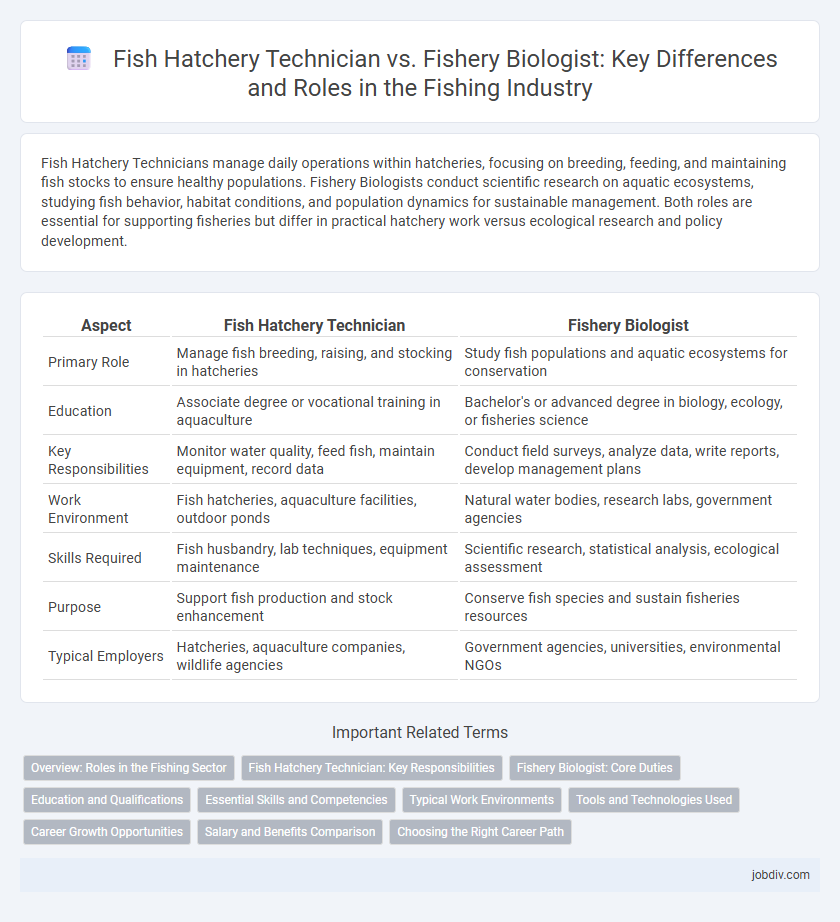Fish Hatchery Technicians manage daily operations within hatcheries, focusing on breeding, feeding, and maintaining fish stocks to ensure healthy populations. Fishery Biologists conduct scientific research on aquatic ecosystems, studying fish behavior, habitat conditions, and population dynamics for sustainable management. Both roles are essential for supporting fisheries but differ in practical hatchery work versus ecological research and policy development.
Table of Comparison
| Aspect | Fish Hatchery Technician | Fishery Biologist |
|---|---|---|
| Primary Role | Manage fish breeding, raising, and stocking in hatcheries | Study fish populations and aquatic ecosystems for conservation |
| Education | Associate degree or vocational training in aquaculture | Bachelor's or advanced degree in biology, ecology, or fisheries science |
| Key Responsibilities | Monitor water quality, feed fish, maintain equipment, record data | Conduct field surveys, analyze data, write reports, develop management plans |
| Work Environment | Fish hatcheries, aquaculture facilities, outdoor ponds | Natural water bodies, research labs, government agencies |
| Skills Required | Fish husbandry, lab techniques, equipment maintenance | Scientific research, statistical analysis, ecological assessment |
| Purpose | Support fish production and stock enhancement | Conserve fish species and sustain fisheries resources |
| Typical Employers | Hatcheries, aquaculture companies, wildlife agencies | Government agencies, universities, environmental NGOs |
Overview: Roles in the Fishing Sector
Fish Hatchery Technicians primarily manage breeding, hatching, and rearing fish to support population sustainability and commercial aquaculture operations, specializing in monitoring water quality, feeding, and health assessments. Fishery Biologists conduct research on fish populations, ecosystems, and environmental impacts to inform conservation strategies and sustainable management policies, often working with government agencies and environmental organizations. Both roles are critical in maintaining fishery resources, with Hatchery Technicians focusing on propagation and rearing processes, while Biologists emphasize scientific analysis and habitat protection.
Fish Hatchery Technician: Key Responsibilities
Fish Hatchery Technicians maintain and monitor aquatic environments to ensure optimal conditions for breeding and raising fish species, including water quality testing, feeding, and health assessments. They operate and maintain specialized equipment such as pumps, aerators, and filtration systems to support fish development in hatchery settings. Technicians also document growth rates, disease occurrences, and environmental parameters to aid in fish population management and conservation efforts.
Fishery Biologist: Core Duties
Fishery biologists conduct scientific research to assess fish populations, habitats, and ecosystem health, using data to inform sustainable management and conservation strategies. They analyze environmental impacts, develop resource management plans, and collaborate with regulatory agencies to ensure compliance with fishing laws and habitat protection. Fishery biologists also monitor fish reproduction and migration patterns, contributing to the preservation of biodiversity and aquatic ecosystems.
Education and Qualifications
Fish Hatchery Technicians typically require an associate degree or relevant certification in aquaculture or fisheries technology, emphasizing hands-on skills in fish breeding and hatchery operations. Fishery Biologists usually hold a bachelor's degree or higher in fisheries science, biology, or environmental science, with advanced studies often involving ecological research and population management. Professional credentials for Fishery Biologists may include fieldwork experience, GIS proficiency, and data analysis techniques that extend beyond the technical hatchery-focused training of technicians.
Essential Skills and Competencies
Fish Hatchery Technicians require strong technical skills in water quality management, hatchery equipment operation, and larval fish care to ensure optimal growth environments. Fishery Biologists must possess advanced competencies in data analysis, ecological assessment, and species population modeling to develop sustainable management plans. Both roles demand a solid understanding of aquatic biology, but the technician emphasizes hands-on operational tasks while the biologist focuses on research and policy development.
Typical Work Environments
Fish Hatchery Technicians commonly work in controlled aquaculture facilities, including freshwater hatcheries, fish farms, and research laboratories where they monitor fish health and manage breeding programs. Fishery Biologists typically operate in a wider range of environments such as rivers, lakes, coastal areas, and marine ecosystems, conducting field surveys and collecting data on fish populations and habitats. Both professionals may collaborate with government agencies, conservation organizations, and research institutions to support sustainable fisheries management.
Tools and Technologies Used
Fish Hatchery Technicians primarily utilize equipment such as water quality testing kits, automated feeders, and hatchery tanks to monitor and manage fish development in controlled environments. Fishery Biologists employ advanced technologies including geographic information systems (GIS), sonar mapping, and data analytics software to study fish populations and aquatic ecosystems in natural habitats. Both roles rely on telemetry devices and genetic analysis tools to support conservation and sustainable fishery management efforts.
Career Growth Opportunities
Fish Hatchery Technicians typically gain hands-on experience in breeding and rearing fish, providing a solid foundation for advancing to supervisory roles or specialized hatchery management positions. Fishery Biologists often have broader career growth opportunities in research, conservation, and environmental assessment, with potential pathways into policy development, academic research, or consultancy roles. Both careers value field expertise, but Fishery Biologists generally require advanced degrees for higher-level positions and offer greater scope for leadership in ecosystem management and scientific studies.
Salary and Benefits Comparison
Fish Hatchery Technicians typically earn a median salary of $38,000 to $45,000 annually, with benefits including health insurance and retirement plans, but often less comprehensive than those offered to Fishery Biologists. Fishery Biologists command higher salaries ranging from $55,000 to $75,000 per year, reflecting their advanced education and responsibilities, alongside enhanced benefits such as professional development opportunities and performance bonuses. The salary and benefits disparity is influenced by the complexity of tasks, required credentials, and experience levels in fishery management roles.
Choosing the Right Career Path
Fish Hatchery Technicians manage breeding, rearing, and health of fish populations in controlled environments, ensuring optimal growth conditions and disease prevention. Fishery Biologists conduct field research on aquatic ecosystems, analyze fish populations, and develop conservation strategies to maintain sustainable fisheries. Choosing the right career path depends on preference for hands-on hatchery work versus research-driven ecosystem management.
Fish Hatchery Technician vs Fishery Biologist Infographic

 jobdiv.com
jobdiv.com